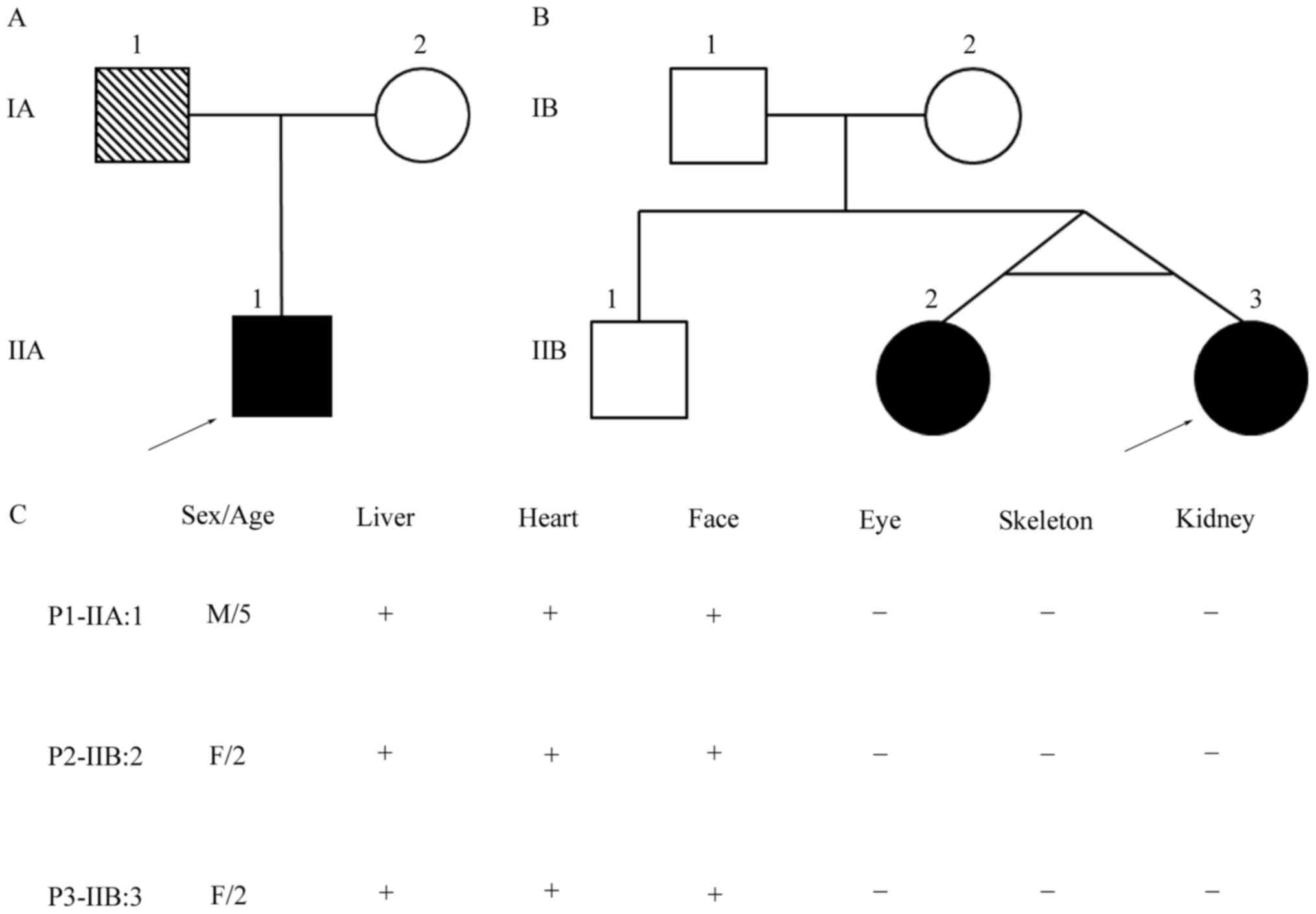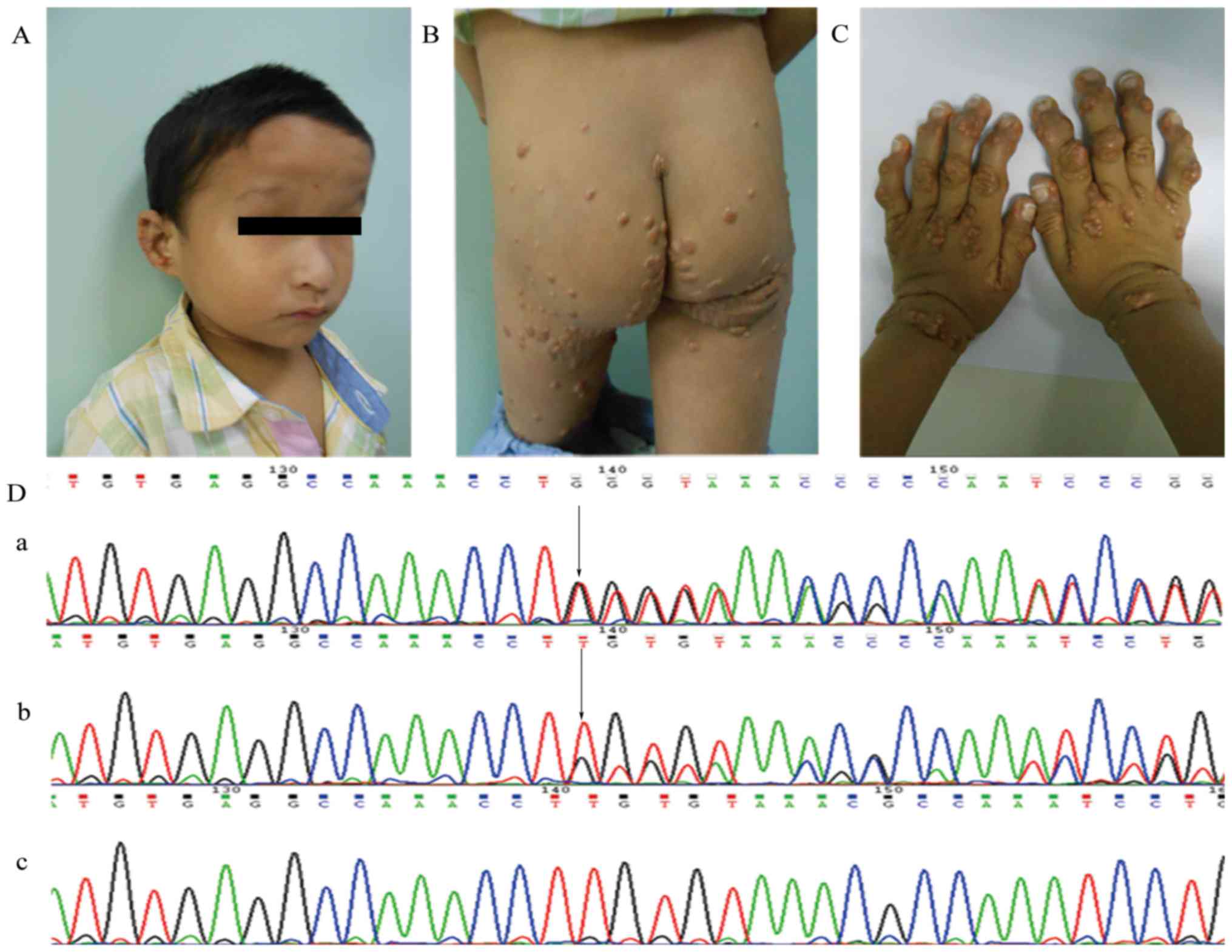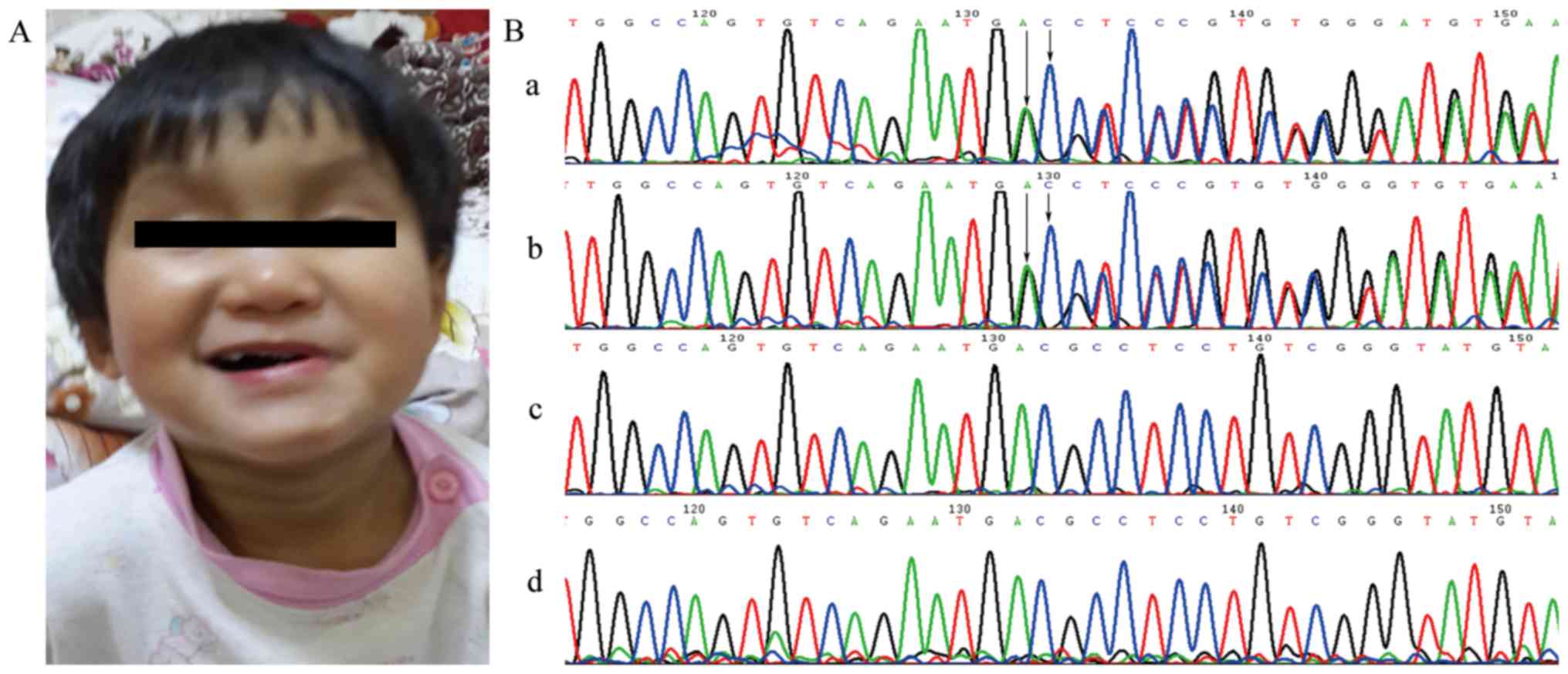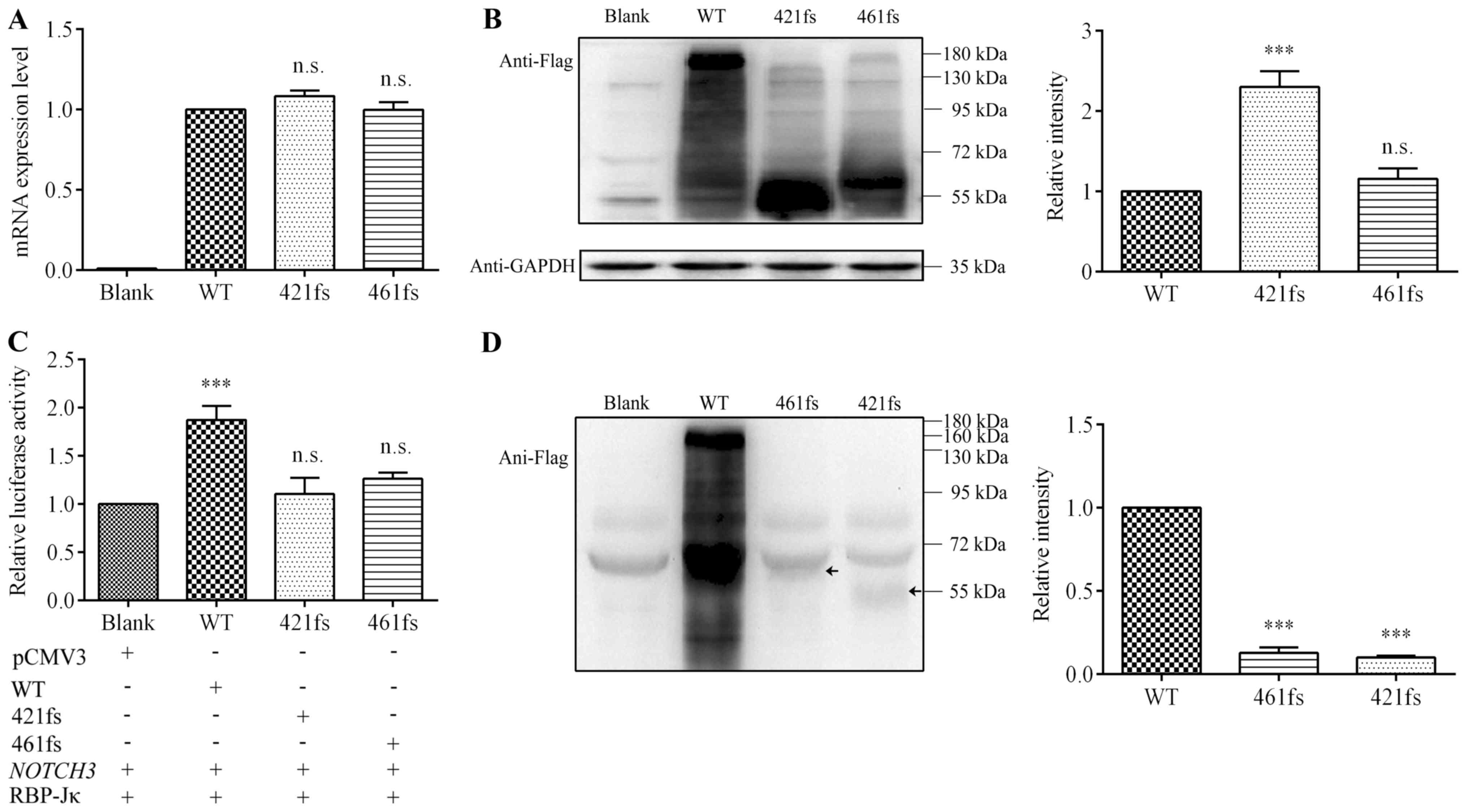|
1
|
Loomes KM, Underkoffler LA, Morabito J,
Gottlieb S, Piccoli DA, Spinner NB, Baldwin HS and Oakey RJ: The
expression of Jagged1 in the developing mammalian heart correlates
with cardiovascular disease in Alagille syndrome. Hum Mol Genet.
8:2443–2449. 1999. View Article : Google Scholar : PubMed/NCBI
|
|
2
|
Giannakudis J, Röpke A, Kujat A,
Krajewska-Walasek M, Hughes H, Fryns JP, Bankier A, Amor D,
Schlicker M and Hansmann I: Parental mosaicism of JAG1 mutations in
families with Alagille syndrome. Eur J Hum Genet. 9:209–216. 2001.
View Article : Google Scholar : PubMed/NCBI
|
|
3
|
Tada M, Itoh S, Ishii-Watabe A, Suzuki T
and Kawasaki N: Functional analysis of the Notch ligand Jagged1
missense mutant proteins underlying Alagille syndrome. FEBS J.
279:2096–2107. 2012. View Article : Google Scholar : PubMed/NCBI
|
|
4
|
Bauer RC, Laney AO, Smith R, Gerfen J,
Morrissette JJ, Woyciechowski S, Garbarini J, Loomes KM, Krantz ID,
Urban Z, et al: Jagged1 (JAG1) mutations in patients with tetralogy
of Fallot or pulmonic stenosis. Hum Mutat. 31:594–601. 2010.
View Article : Google Scholar : PubMed/NCBI
|
|
5
|
Krantz ID, Piccoli DA and Spinner NB:
Clinical and molecular genetics of Alagille syndrome. Curr Opin
Pediatr. 11:558–564. 1999. View Article : Google Scholar : PubMed/NCBI
|
|
6
|
Li L, Krantz ID, Deng Y, Genin A, Banta
AB, Collins CC, Qi M, Trask BJ, Kuo WL, Cochran J, et al: Alagille
syndrome is caused by mutations in human Jagged1, which encodes a
ligand for Notch1. Nat Genet. 16:243–251. 1997. View Article : Google Scholar : PubMed/NCBI
|
|
7
|
Oda T, Elkahloun AG, Pike BL, Okajima K,
Krantz ID, Genin A, Piccoli DA, Meltzer PS, Spinner NB, Collins FS
and Chandrasekharappa SC: Mutations in the human Jagged1 gene are
responsible for Alagille syndrome. Nat Genet. 16:235–242. 1997.
View Article : Google Scholar : PubMed/NCBI
|
|
8
|
McDaniell R, Warthen DM, Sanchez-Lara PA,
Pai A, Krantz ID, Piccoli DA and Spinner NB: NOTCH2 mutations cause
Alagille syndrome, a heterogeneous disorder of the notch signaling
pathway. Am J Hum Genet. 79:169–173. 2006. View Article : Google Scholar : PubMed/NCBI
|
|
9
|
Penton AL, Leonard LD and Spinner NB:
Notch signaling in human development and disease. Semin Cell Dev
Biol. 23:450–457. 2012. View Article : Google Scholar : PubMed/NCBI
|
|
10
|
Leonard LD, Chao G, Baker A, Loomes K and
Spinner NB: Clinical utility gene card for: Alagille Syndrome
(ALGS). Eur J Hum Genet. 22:2014.(doi: 10.1038/ejhg.2013).
View Article : Google Scholar : PubMed/NCBI
|
|
11
|
Turnpenny PD and Ellard S: Alagille
syndrome: Pathogenesis, diagnosis and management. Eur J Hum Genet.
20:251–257. 2012. View Article : Google Scholar : PubMed/NCBI
|
|
12
|
Kamath BM, Bauer RC, Loomes KM, Chao G,
Gerfen J, Hutchinson A, Hardikar W, Hirschfield G, Jara P, Krantz
ID, et al: NOTCH2 mutations in Alagille syndrome. J Med Genet.
49:138–144. 2012. View Article : Google Scholar : PubMed/NCBI
|
|
13
|
Warthen DM, Moore EC, Kamath BM,
Morrissette JJ, Sanchez-Lara PA, Piccoli DA, Krantz ID and Spinner
NB: Jagged1 (JAG1) mutations in Alagille syndrome: Increasing the
mutation detection rate. Hum Mutat. 27:436–443. 2006. View Article : Google Scholar : PubMed/NCBI
|
|
14
|
Boyer J, Crosnier C, Driancourt C, Raynaud
N, Gonzales M, Hadchouel M and Meunier-Rotival M: Expression of
mutant JAGGED1 alleles in patients with Alagille syndrome. Hum
Genet. 116:445–453. 2005. View Article : Google Scholar : PubMed/NCBI
|
|
15
|
Boyer-Di Ponio J, Wright-Crosnier C,
Groyer-Picard MT, Driancourt C, Beau I, Hadchouel M and
Meunier-Rotival M: Biological function of mutant forms of JAGGED1
proteins in Alagille syndrome: Inhibitory effect on Notch
signaling. Hum Mol Genet. 16:2683–2692. 2007. View Article : Google Scholar : PubMed/NCBI
|
|
16
|
Morrissette JD, Colliton RP and Spinner
NB: Defective intracellular transport and processing of JAG1
missense mutations in Alagille syndrome. Hum Mol Genet. 10:405–413.
2001. View Article : Google Scholar : PubMed/NCBI
|
|
17
|
Liu C, Yang C, Lu L, Wang W, Tan W, Leung
CH and Ma DL: Luminescent iridium(iii) complexes as COX-2-specific
imaging agents in cancer cells. Chem Commun (Camb). 53:2822–2825.
2017. View Article : Google Scholar : PubMed/NCBI
|
|
18
|
Lincoln R, Greene LE, Zhang W, Louisia S
and Cosa G: Mitochondria alkylation and cellular trafficking mapped
with a lipophilic BODIPY-acrolein fluorogenic probe. J Am Chem Soc.
139:16273–16281. 2017. View Article : Google Scholar : PubMed/NCBI
|
|
19
|
Lin S, Gao W, Tian Z, Yang C, Lu L, Mergny
JL, Leung CH and Ma DL: Luminescence switch-on detection of protein
tyrosine kinase-7 using a G-quadruplex-selective probe. Chem Sci.
6:4284–4290. 2015. View Article : Google Scholar : PubMed/NCBI
|
|
20
|
Lu F, Morrissette JJ and Spinner NB:
Conditional JAG1 mutation shows the developing heart is more
sensitive than developing liver to JAG1 dosage. Am J Hum Genet.
72:1065–1070. 2003. View
Article : Google Scholar : PubMed/NCBI
|
|
21
|
Zhang E, Hong N, Chen S, Fu Q, Li F, Yu Y
and Sun K: Targeted sequencing identifies novel GATA6 variants in a
large cohort of patients with conotruncal heart defects. Gene.
641:341–348. 2018. View Article : Google Scholar : PubMed/NCBI
|
|
22
|
Pu T, Liu Y, Xu R, Li F, Chen S and Sun K:
Identification of ZFPM2 mutations in sporadic conotruncal heart
defect patients. Mol Genet Genomics. 293:217–223. 2018. View Article : Google Scholar : PubMed/NCBI
|
|
23
|
Livak KJ and Schmittgen TD: Analysis of
relative gene expression data using real-time quantitative PCR and
the 2(-Delta Delta C(T)) method. Methods. 25:402–408. 2001.
View Article : Google Scholar : PubMed/NCBI
|
|
24
|
Li L, Dong J, Wang X, Guo H, Wang H, Zhao
J, Qiu Y, Abuduxikuer K and Wang J: JAG1 mutation spectrum and
origin in chinese children with clinical features of alagille
syndrome. PLoS One. 10:e01303552015. View Article : Google Scholar : PubMed/NCBI
|
|
25
|
Grochowski CM, Loomes KM and Spinner NB:
Jagged1 (JAG1): Structure, expression, and disease associations.
Gene. 576:381–384. 2016. View Article : Google Scholar : PubMed/NCBI
|
|
26
|
Chillakuri CR, Sheppard D, Lea SM and
Handford PA: Notch receptor-ligand binding and activation: Insights
from molecular studies. Semin Cell Dev Biol. 23:421–428. 2012.
View Article : Google Scholar : PubMed/NCBI
|
|
27
|
Cordle J, Johnson S, Tay JZ, Roversi P,
Wilkin MB, de Madrid BH, Shimizu H, Jensen S, Whiteman P, Jin B, et
al: A conserved face of the Jagged/Serrate DSL domain is involved
in Notch trans-activation and cis-inhibition. Nat Struct Mol Biol.
15:849–857. 2008. View Article : Google Scholar : PubMed/NCBI
|
|
28
|
Lykke-Andersen S and Jensen TH:
Nonsense-mediated mRNA decay: An intricate machinery that shapes
transcriptomes. Nat Rev Mol Cell Biol. 16:665–677. 2015. View Article : Google Scholar : PubMed/NCBI
|
|
29
|
He F and Jacobson A: Nonsense-mediated
mRNA decay: Degradation of defective transcripts is only part of
the story. Annu Rev Genet. 49:339–366. 2015. View Article : Google Scholar : PubMed/NCBI
|
|
30
|
Mocquet V, Durand S and Jalinot P: How
retroviruses escape the nonsense-mediated mRNA decay. AIDS Res Hum
Retroviruses. 31:948–958. 2015. View Article : Google Scholar : PubMed/NCBI
|
|
31
|
Neu-Yilik G, Amthor B, Gehring NH, Bahri
S, Paidassi H, Hentze MW and Kulozik AE: Mechanism of escape from
nonsense-mediated mRNA decay of human beta-globin transcripts with
nonsense mutations in the first exon. RNA. 17:843–854. 2011.
View Article : Google Scholar : PubMed/NCBI
|
|
32
|
Ferraiuolo MA, Lee CS, Ler LW, Hsu JL,
Costa-Mattioli M, Luo MJ, Reed R and Sonenberg N: A nuclear
translation-like factor eIF4AIII is recruited to the mRNA during
splicing and functions in nonsense-mediated decay. Proc Natl Acad
Sci USA. 101:4118–4123. 2004. View Article : Google Scholar : PubMed/NCBI
|
|
33
|
Neu-Yilik G, Gehring NH, Thermann R, Frede
U, Hentze MW and Kulozik AE: Splicing and 3′end formation in the
definition of nonsense-mediated decay-competent human beta-globin
mRNPs. EMBO J. 20:532–540. 2001. View Article : Google Scholar : PubMed/NCBI
|
|
34
|
Yuan ZR, Kobayashi N and Kohsaka T: Human
Jagged 1 mutants cause liver defect in Alagille syndrome by
overexpression of hepatocyte growth factor. J Mol Biol.
356:559–568. 2006. View Article : Google Scholar : PubMed/NCBI
|
|
35
|
Sparks EE, Huppert KA, Brown MA,
Washington MK and Huppert SS: Notch signaling regulates formation
of the three-dimensional architecture of intrahepatic bile ducts in
mice. Hepatology. 51:1391–1400. 2010. View Article : Google Scholar : PubMed/NCBI
|
|
36
|
High FA and Epstein JA: The multifaceted
role of Notch in cardiac development and disease. Nat Rev Genet.
9:49–61. 2008. View Article : Google Scholar : PubMed/NCBI
|
|
37
|
Humphreys R, Zheng W, Prince LS, Qu X,
Brown C, Loomes K, Huppert SS, Baldwin S and Goudy S: Cranial
neural crest ablation of Jagged1 recapitulates the craniofacial
phenotype of Alagille syndrome patients. Hum Mol Genet.
21:1374–1383. 2012. View Article : Google Scholar : PubMed/NCBI
|
|
38
|
Kamath BM, Bason L, Piccoli DA, Krantz ID
and Spinner NB: Consequences of JAG1 mutations. J Med Genet.
40:891–895. 2003. View Article : Google Scholar : PubMed/NCBI
|


















